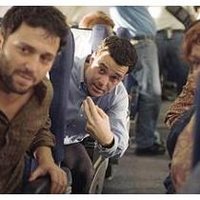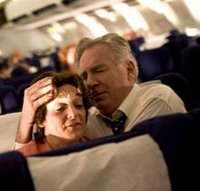 On September 11, 2001, United Airlines Flight 93 departed Newark for San Francisco with 33 passengers and seven crew members. Four of the passengers were an Al-Quaeda cell, and the plane became the fourth to be hijacked that awful day. United 93 tells what happened, in real time, aboard the plane and on the ground. It cuts between the passengers and crew aboard the plane, air traffic controllers, and military commanders, and shows the struggle to understand the unthinkable and the slow realization by the passengers that they have to band together and do something or they will become the victims of a suicide mission that will kill people on the ground as well as themselves.
On September 11, 2001, United Airlines Flight 93 departed Newark for San Francisco with 33 passengers and seven crew members. Four of the passengers were an Al-Quaeda cell, and the plane became the fourth to be hijacked that awful day. United 93 tells what happened, in real time, aboard the plane and on the ground. It cuts between the passengers and crew aboard the plane, air traffic controllers, and military commanders, and shows the struggle to understand the unthinkable and the slow realization by the passengers that they have to band together and do something or they will become the victims of a suicide mission that will kill people on the ground as well as themselves.Writer and director Paul Greengrass has crafted an astonishing, tense, beautifully shot, edited, and acted syncretism of fiction and documentary filmmaking. As in Greengrass’ similarly excellent Bloody Sunday, United 93 uses, brilliantly, several tactics to drop viewers in the centre of the events and ratchet up the verisimilitude.
Greengrass shoots the film using handheld cameras and grainy film stock. As in a documentary film, the cameras follow characters around and pan quickly from person to person in an attempt to take in vital conversations. Crucial dialogue and actions often happen at the edges of the frame, forcing us to strain to take in everything, exactly as if we were an observer on the ground. The film’s POV offers no Godlike omniscience; we know exactly as much as the characters know, as they know it. There are no shots in the film that could not be interpreted as the view of a human observer.
 Many of the actors are simply playing themselves in the roles that they inhabited that day. Ben Sliney, for instance, plays himself as he was, the supervisor of the National Air Traffic Control Center in Herndon, Va. The passengers are played by an ensemble of mostly unknown actors. These actors studied the lives of their real life counterparts and together with Greengrass, partially improvised the dialogue and actions aboard Flight 93. Dialogue is sharp but underwritten, frequently overlapping as in real life when events race ahead of people’s ability to take them in. All the people in the film are humanized, even the terrorists aboard the plane, so we can relate on some level to everyone.
Many of the actors are simply playing themselves in the roles that they inhabited that day. Ben Sliney, for instance, plays himself as he was, the supervisor of the National Air Traffic Control Center in Herndon, Va. The passengers are played by an ensemble of mostly unknown actors. These actors studied the lives of their real life counterparts and together with Greengrass, partially improvised the dialogue and actions aboard Flight 93. Dialogue is sharp but underwritten, frequently overlapping as in real life when events race ahead of people’s ability to take them in. All the people in the film are humanized, even the terrorists aboard the plane, so we can relate on some level to everyone. The result of Greengrass’ ‘fictional documentary’ techniques is an utterly convincing journey into the events on the ground and aboard Flight 93. And the ultimate effect is completely harrowing. The final 30 minutes of United 93 are, without exaggeration, the tensest moments I have ever experienced in a movie. It is, quite properly, frightening and disturbing, but also essential viewing for anyone even slightly interested in exploring the events of September 11 and in studying how cinema can have a profound effect on viewers.
Though the film has no heavy political subtext, there are political messages to be found connected to United 93. According to Greengrass, “by examining this single event something much larger can be found – the shape of our world today.” The passengers and crew of flight 93 were faced with a terrible choice: sit back and hope the situation resolves, or fight back and face the potentially devastating consequences. The world has faced this dilemma since 9/11, but there has been another choice, the nature of the fight. Many have naturally assumed that ‘fight’ means violence, and the shape of the West’s response has been military. Flight 93 ended in destruction for both sides. There are other ways to fight. Greengrass has also opined that there were two hijackings that took place that day: the hijacking of the planes by terrorists, and the hijacking of Islam by religious fanaticism. U.S. actions have certainly made that latter hijacking more effective. Another point raised in the film is the complete inability of the military to receive authorization to use force against the hijacked planes and clear rules of engagement. A further discussion United 93 may raise is the appropriateness of the U.S. government’s response to the attacks.
At its core, though, United 93 is about a group of people, on the ground and in the air, who have to rapidly come to grips with the unthinkable. In its depiction of the responses of terrified, confused people to horrific circumstance, United 93 is one of the best films of its type ever made.
---
Written and Directed by Paul Greengrass
(Cast list too long to duplicate here.)

No comments:
Post a Comment